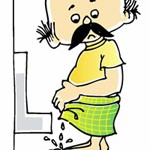 Saw palmetto (Serenoa repens) fruit extracts are used for treat lower urinary tract symptoms attributed to benign prostatic hyperplasia (BPH).
Saw palmetto (Serenoa repens) fruit extracts are used for treat lower urinary tract symptoms attributed to benign prostatic hyperplasia (BPH).
Researchers in the Complementary and Alternative Medicine for Urological Symptoms (CAMUS) Study Group report the response to increasing doses.
First, the details.
- 369 men at least 45 years old, with a peak urinary flow rate of at least 4 mL/second and an American Urological Association Symptom Index (AUASI) score between 8 and 24 (moderate to severe) were assigned to a treatment group.
- Saw palmetto: 1, 2, and then 3 doses (320 mg/day) with dose increases at 24 and 48 weeks.
- Placebo
- Changes in AUASI score at 72 weeks were recorded.
- Also, urinary bother, nocturia, peak urine flow, post-void residual volume, prostate-specific antigen level, participants’ global assessments, and indices of sexual function, continence, sleep quality, and prostatitis symptoms were recorded.
- Neither the patients nor researchers knew the treatment given — double blind.
And, the results.
- Between the start of the study and 72 weeks later, AUASI scores decreased similarly: from 14 to 12 points with saw palmetto extract and from 15 to 12 points with placebo.
- Saw palmetto extract was no more effective than placebo for any or the other outcomes.
- No clearly attributable adverse effects were identified.
The bottom line?
The authors concluded, “Increasing doses of a saw palmetto fruit extract did not reduce lower urinary tract symptoms more than placebo.”
The results support a 2007 Cochrane review, which concluded that Serenoa repens was well tolerated, but no better than placebo for improving urinary symptom scores.
10/12/11 21:36 JR